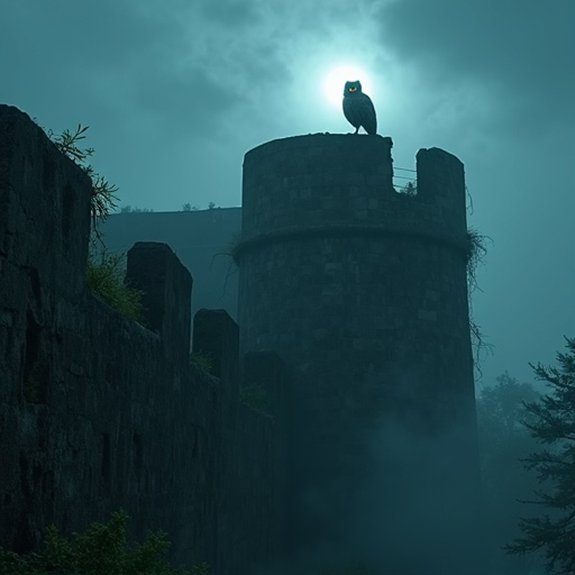The Haunted Maharashtra Forts of India
Maharashtra’s ancient forts don’t just echo with battle cries from centuries past—they’re said to harbor something far more unsettling. Visitors to these Maratha strongholds often report phantom soldiers marching through empty corridors and unexplained chills that defy India’s sweltering heat. While historians document these sites’ bloody sieges and political intrigue, paranormal investigators chase an entirely different narrative that’s been unfolding within these stone walls for generations.
Introduction

Shadows dance across ancient stone walls as twilight descends on Maharashtra’s historic forts, where centuries of warfare, betrayal, and tragedy have left their mark on more than just the architecture. These imposing structures, once bastions of the Maratha Empire, now attract paranormal investigators and thrill-seekers who’ve reported unexplained phenomena within their weathered ramparts.
Maharashtra’s forts tell stories that transcend historical records. Locals whisper about ghostly soldiers patrolling abandoned battlements, mysterious lights flickering in empty chambers, and disembodied voices echoing through deserted corridors. From Shaniwarwada’s burning legacy to Bhangarh’s cursed reputation, each fort harbors its own supernatural narrative. These sites blend documented history with folklore, creating an atmosphere where visitors can’t distinguish between imagination and genuine paranormal activity. They’ve become destinations where India’s martial past meets its mystical present.
Ancient Maratha Warrior Strongholds
The Maratha Empire’s military prowess manifested in a network of formidable hill forts that dominated Maharashtra’s landscape from the 17th to 19th centuries. These strategic strongholds served as administrative centers, treasuries, and defensive bastions against Mughal and British forces. Shivaji Maharaj pioneered guerrilla warfare tactics from these elevated positions, utilizing the Sahyadri mountain range’s natural defenses.
Today, many forts like Shivneri, Raigad, and Pratapgad aren’t just historical monuments—they’re considered among India’s most haunted locations. Locals report hearing phantom war cries, clanging swords, and marching footsteps echoing through empty corridors at night. Shadow figures in traditional Maratha armor allegedly patrol ramparts where soldiers once stood guard. These supernatural occurrences have transformed ancient military sites into destinations for paranormal investigators seeking evidence of restless warrior spirits.
Notable Cases or Sightings

Several documented encounters at Maharashtra’s forts have attracted national attention and sparked investigations by paranormal researchers. At Shaniwar Wada, Pune’s most notorious site, visitors’ve reported hearing a young prince’s screams echoing “Kaka mala vachva” (Uncle, save me) on full moon nights. The boy’s murder in 1773 allegedly cursed the fortress.
Bhangarh Fort’s reputation draws thrill-seekers who’ve filmed unexplained shadows and recorded temperature drops near the ruined palace chambers. Security guards at Sinhagad Fort describe witnessing spectral warriors on horseback patrolling the ramparts after midnight.
In 2019, a documentary crew captured thermal anomalies at Pratapgad Fort’s execution grounds. Local guides won’t enter certain sections after dusk, citing encounters with vengeful spirits of prisoners who died during Maratha-Mughal conflicts.
Common Theories or Explanations
While paranormal enthusiasts attribute these phenomena to restless spirits, researchers’ve proposed several scientific explanations for the reported hauntings at Maharashtra’s forts. Acoustic experts point to the stone architecture’s ability to create echo chambers and amplify sounds, making footsteps seem otherworldly. The forts’ elevation causes temperature fluctuations that produce unexplained drafts and cold spots visitors often mistake for supernatural presence.
Psychologists cite the power of suggestion and collective hysteria, where groups experiencing fear together validate each other’s perceptions. The historical trauma associated with these sites triggers heightened emotional responses. Additionally, infrasound—frequencies below human hearing—generated by wind passing through ancient structures can cause anxiety, hallucinations, and feelings of being watched. Carbon monoxide from deteriorating materials in enclosed spaces may also induce visual and auditory hallucinations that witnesses interpret as ghostly encounters.
Frequently Asked Questions
What Is the Best Time of Year to Visit These Haunted Forts?
Visitors’ll find October through March ideal for exploring Maharashtra’s haunted forts. The weather’s cooler and drier during these months, making nighttime ghost tours more comfortable. Monsoons from June to September make trails slippery and dangerous.
Are Guided Ghost Tours Available at Any of These Locations?
Yes, several haunted Maharashtra forts offer guided ghost tours. Bhangarh Fort’s gained popularity for night walks, while Shaniwarwada Fort in Pune conducts evening heritage tours that include paranormal stories. Local operators also organize supernatural-themed visits.
Can Visitors Stay Overnight Inside the Fort Premises?
Visitors can’t typically stay overnight inside most haunted Maharashtra fort premises due to safety regulations. However, some forts like Sinhagad offer nearby camping options, while Raigad’s closed after sunset. Authorities don’t permit overnight stays for visitor protection.
What Safety Precautions Should Tourists Take When Exploring These Sites?
Tourists shouldn’t explore alone after dark and they’ll need sturdy footwear for uneven terrain. They must carry flashlights, water, and first-aid supplies. Hiring local guides guarantees safer navigation through crumbling structures and steep pathways.
Are Photography and Videography Permitted in All Areas of These Forts?
Photography’s generally allowed in Maharashtra’s haunted forts, but visitors can’t film in restricted archaeological zones or sacred areas. They’ll need permits for commercial shoots, and some forts prohibit flash photography near ancient murals and artifacts.
Related Posts

Haunting Residences of Famous Authors

Ghost Ships That Sail the Seas Forever
